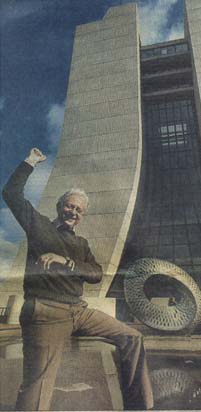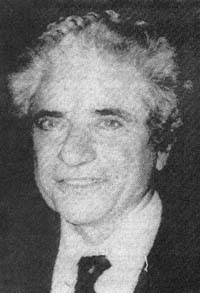Fermilab Chief Shares Nobel Prize
The mood was distinctly bittersweet at Fermilab on Wednesday.
First, Leon Lederman, the lab's director, learned in an early-morning telephone call from Stockholm that he was one of three American scientists to share this year's Nobel Prize for Physics for their work on subatomic particles.
Then the well-liked Lederman, 66, announced that he will soon be leaving Fermilab, which he has headed since 1979, to tackle the nation's "frightening" level of science illiteracy as a professor at the University of Chicago.
The Royal Swedish Academy of Sciences announced Wednesday that Lederman had won the prestigious $390,000 prize along with Jack Steinberger, 67, a graduate of the University of Chicago, and Melvin Schwartz, 55, a former Stanford University professor who currently operates a computer company in California's Silicon Valley.
Steinberger, who works at the CERN research laboratory in Switzerland, is a German emigre who attended New Trier High School in Winnetka and used to work in his parents' delicatessen on Glenwood Avenue in Chicago.
At Fermilab in Batavia, one of the world's premier high-energy physics research centers, scientists and staff workers reacted to the Nobel announcement with excitement and glee.
The laboratory's 800-seat auditorium was overflowing with employees who came to toast Lederman, science and themselves with champagne, beer, wine and soda.
"I would compare it to a company whose stock has just doubled overnight," said Joseph Lach, a Fermilab physicist.
Lederman had been offered another five-year term as director of the facility, home of the world's most powerful atom smasher and a finalist in the race for the proposed $6 billion superconducting supercollider.
But he had decided to join the U. of C. faculty next March to devote his time to teaching, research and developing science education programs with mass appeal, Lederman said.
"Science illiteracy in this country is really a terrible problem," he said. "We're just not getting the bright kids going into science in school, and our graduate science programs have very few Americans."
Lederman played a key role in the creation of the Illinois Science and Math Academy in Aurora, a free public boarding school for gifted youngsters. He also set up a program of Saturday morning physics classes at Fermilab.
"If parents are uncomfortable with science, then their children are going to be uncomfortable, too," he said. "If college graduates who go into teaching are uncomfortable with science, so will their students be uncomfortable."
Lederman can attest to the "fun" in physics, because the Nobel Prize that he and his colleagues shared was awarded for their successful search to find one of the universe's so-called "ghost" particles, the muon neutrino.
Lederman once called the particle "barely a fact" because it had no electric charge or measurable mass, and it traveled at the speed of light and could pass through 100 million miles of steel without touching a single atom. Yet its discovery in 1961, when the three new Nobel laureates were researchers at Columbia University, showed that nature is much simpler than anyone had thought. By that time, hundreds of particles had been discovered, throwing physics into confusion.
The discovery of the muon neutrino, which began in a conversation among the three men during a coffee break, opened up an era of prodigious research that showed that all matter and energy in the universe appear to be made up of two fundamental families of particles: quarks and leptons.
"The prize, I think, was for the fact that not only did we discover a neutrino, but that neutrino turned out to be extremely useful as a tool in studying and elucidating the properties of particles," Lederman said.
By combining the postulated six quarks and six leptons in different ways, scientists were able to forge a new understanding of how the universe works, a theory called the Standard Model. Quarks form the protons and neutrons in the nuclei of atoms that give matter its substance; leptons, including electrons, give matter its "personality traits." Electrons, for instance, give atoms their chemical properties.
Five of the quarks have been found. Lederman played a leading role in finding the so-called "bottom" one in 1977, using a Fermilab atom smasher. Particle physicists are currently in a race to find the sixth one, the "top" quark.
Lederman received hundreds of congratulalory calls and telegrams from well-wishers, including Gov. James Thompson and U.S. Sen. Alan Dixon. But Thompson said he doubted the Nobel Prize would exert significant influence on the federal government's decision on where to locate the proposed superconducting supercollider. Seven states, including Illinois, are vying for the new atom smasher.
Lederman said he was most touched by the reaction of his fellow staffers at Fermilab.
"The lab is very excited," he said. "People come up to me and say, 'I'm very proud to work at Ferrnilab.' That warms you deep down inside. This is just the first of a large number of Nobels that will be won at Fermilab, You just have to be patient."





